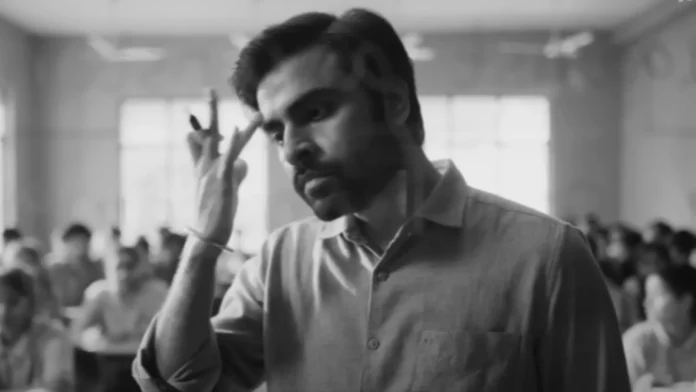“Kota Factory” Season 3, featuring Jitendra Kumar and Tillotama Shome, continues its blend of drama and philosophy but fails to tackle the core issue it seeks to critique. The cast, particularly Kumar and Shome, remains the main strength of the series. However, the narrative tends to be repetitive, not delving deeply enough into the complexities of the world it portrays.
In this season, a new character, chemistry teacher Pooja Didi, played by Tillotama Shome, enters the scene. Her reluctance to stay in Kota, describing it as a “factory” focused solely on producing successful IIT and NEET applicants, underscores the show’s critique. Despite this, the dominant portrayal of Kota remains largely unchanged. The city’s depiction as a relentless production line for successful candidates persists, as one character aptly notes, it’s ingrained in Kota’s DNA.The series retains its dramatic black-and-white aesthetic and sleek aerial cinematography, which adds a distinctive visual appeal. However, many elements fall apart this season. The show seems trapped in its basic premise, depicting Kota as a factory, even though its intention is to critique this very trend. The final episode of the season, titled “Product Delivery,” highlights this contradiction by referring to successful candidates as ‘products.’ This approach inadvertently glorifies the very rat race it aims to critique, showing teenagers caught in the relentless pursuit of success.Despite attempts to explore different aspects of Kota through the stories of various IIT aspirants and their attentive mentor Jeetu Bhaiya, the narrative feels redundant. The series struggles to offer fresh insights or solutions to the issues it highlights. The repetitive focus on the pressures and competition in Kota detracts from a deeper examination of the systemic problems within the education system.The introduction of Pooja Didi provides a fresh perspective, but her character’s insights into the flaws of Kota’s education culture are not fully explored. The show misses an opportunity to dive into more profound critiques or offer meaningful alternatives to the existing system.”Kota Factory” Season 3 ultimately falls short of addressing its core issues, despite its strong cast and philosophical undertones. The series continues to depict the harsh realities of Kota’s educational environment but fails to move beyond surface-level commentary, leaving viewers with a familiar yet unfulfilled narrative.
“Kota Factory” Season 3 also struggles with pacing issues, as the long-drawn episodes often feel meandering. The repetitiveness of the plot points diminishes the impact of the narrative, causing the show to lose some of its initial charm. The continuous focus on the competitive pressures without offering substantial character development or new plot twists leaves the storyline stagnant.
Moreover, the series attempts to highlight the emotional and mental toll on students but falls short of delivering a nuanced portrayal. The struggles of the students, although depicted with earnestness, seem overshadowed by the constant emphasis on their academic pursuits. This one-dimensional approach reduces the depth of the characters, making it difficult for viewers to fully engage with their personal journeys.
The relationship between Jeetu Bhaiya and his students remains a central element, but even this dynamic starts to feel repetitive. Jeetu Bhaiya’s role as the guiding mentor is well-portrayed by Jitendra Kumar, yet his interactions with the students lack new layers or complexities. The mentor-mentee dialogues, which were once insightful, now seem formulaic and predictable.
Tillotama Shome’s character, Pooja Didi, brings a breath of fresh air to the series, but her potential is underutilized. Her critical perspective on Kota’s education system is compelling, yet the show does not delve deeply enough into her backstory or motivations. This underdevelopment leaves a gap in the narrative, as viewers are left wanting more from her character.
The show’s depiction of Kota as a relentless and harsh environment might resonate with some viewers, but it risks perpetuating a narrow view of the city. By focusing primarily on the competitive aspect, the series neglects to explore other facets of student life in Kota, such as friendships, hobbies, and personal growth beyond academics. This limited portrayal reinforces the very stereotypes the show aims to critique.
Additionally, while the cinematography and aesthetic choices add a unique touch, they can sometimes overshadow the storytelling. The dramatic black-and-white visuals and aerial shots, though striking, occasionally feel like a distraction from the core narrative. The focus on style over substance detracts from the series’ ability to deliver a compelling and impactful story.

